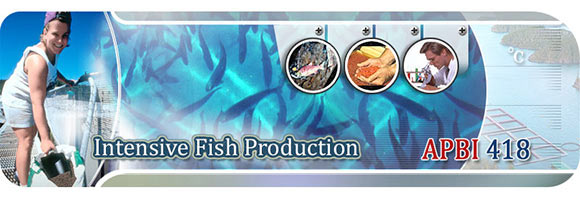
Course Description
The emphasis of the course is on basic fish physiology, fish-water interactions, fish-water-pathogen interactions, and general salmonid husbandry techniques and principles. An understanding of the biology of fish is imperative to allow a more complete understanding of culture techniques and requirements. Management of finfish throughout the life cycle; brood-stock, egg, larvae and juvenile will be examined in this context as will the control of environmental factors, including pathogens, for maximum productivity at all life stages.
A visit to a fish culture facility is required.
Prerequisite
APBI 312 or BIOL 204 or BIOL 361, or BIOL 364, or permission of the instructor.
Intended Student
In order to be successful at fish culture, it is imperative to understand the animals themselves and their requirements. This course is intended for those wishing an introduction to the biology of fish in culture and/or the practicing fish culturist wishing further training in the basic principles behind the practice of intensive fish production. Students in the past have come from a wide variety of backgrounds and talents.
Course Objectives
The course has four main goals. They are:
- to provide you with knowledge in basic fish physiology;
- to have you appreciate the interactions between the fish and its environment. Interactions include physical (water) as well as biological (other fish, pathogens) components;
- to introduce the fundamental facilities and technology as well as the current methods utilized in the intensive production of fish;
- to provide you with the basic tools for understanding the principles in all the major aspects of intensive finfish aquaculture.
Course Overview
This course consists of 5 main units:
Module I: Aquaculture and Aquatic Farming
This module provides an introduction to the subject material. This module will define what aquaculture is; present a historical perspective of aquaculture; explain the concept of aquaculture production systems, methods, and their characteristics; describe the general life cycle of the salmonid fishes and explain the importance of this information to the aquatic farmer.
Module II: Anatomy and Physiology of Salmonid Fishes
This module introduces the basic anatomical structures of the fish and investigates their importance. It will guide you through many of the important physiological adaptations that fish have evolved to exist in the aquatic environment.
Module III: Salmonid Husbandry and Management
In this section students will examine the needs of the fish with respect to its environment; how fish affect their environment; culture techniques for broodstock, incubation, early rearing, grow-out as well as look at handling grading, tagging and transport.
Module IV: Fish Health
This final section of the course will examine the health systems that fish possess. It will also provide a survey of some of the more economically important diseases both infectious and non.
Assignments
There are three written assignments and one site visit report to be completed by the student. Each assignment is worth 10% of the course mark and the site visit is worth 25%. The final examination is worth 30% of the course total. Lesson quizzes comprise the final 15%.
Evaluation
| Assignment #1, 2, 3 | 30% |
| Site Report | 25% |
| Lesson Quizzes | 15% |
| Final Exam | 30% |
| Total | 100% |
Learning Resources
Textbook: There is no required text book.
Recommended Readings: There are many excellent textbooks available and the course will point you towards these as applicable. The course will also list many excellent articles and websites to utilize and many of these are linked to where possible.
